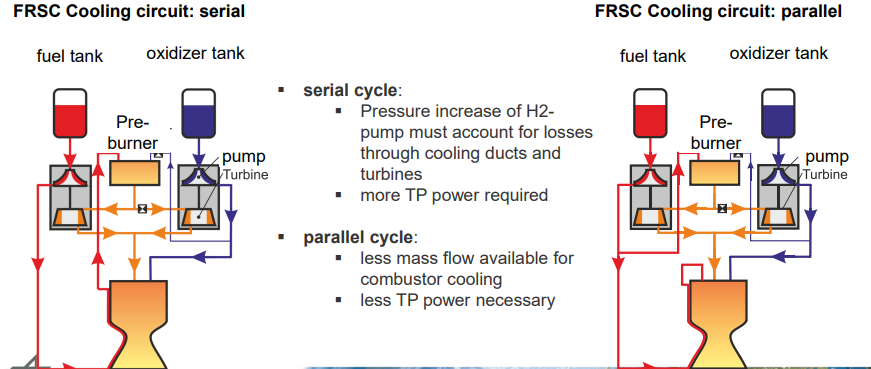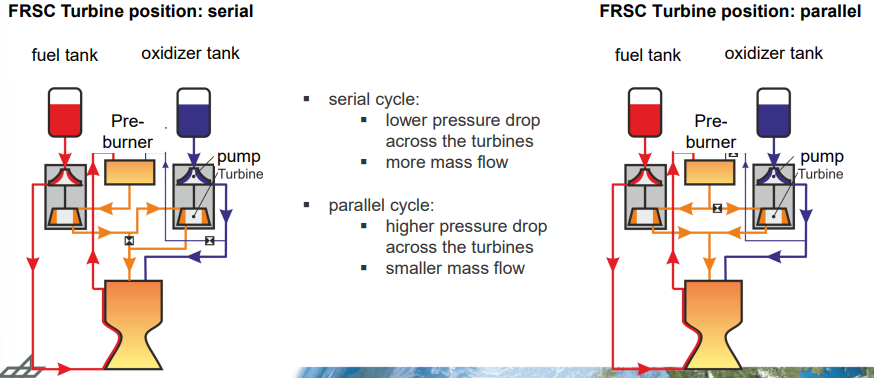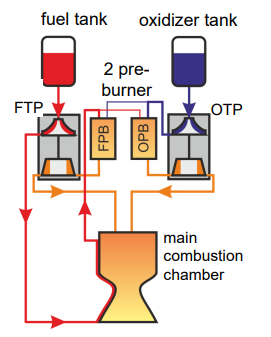L07 - Stage Combustion Fundamentals
1/13
There's no tags or description
Looks like no tags are added yet.
Name | Mastery | Learn | Test | Matching | Spaced |
|---|
No study sessions yet.
14 Terms
Motivation and relevance
Stage combustion engines became a focus in recent years. Starship, Vulcan…
Motivation and relevance
Propellants, and why?
Most engine focus on the bio-methane/LOX.
Eco-friendly
Still high ISP
Motivation and relevance
Applications in terms of stages
Main stage in clustered config
Upper stages
Even kick stages
Engine cycles of liquid rocket engines
Staged combustion cycle
Closed cycle
One or several pre-burner to drive the turbine
One of the two fuel mass flows is completely routed to pre-burner
ROF in pre-burner such that max allowable turbine inlet temp. is not exceeded
Exhaust gases from the turbine are fed to the MCC

Engine cycles of liquid rocket engines
Staged combustion cycle
Variants and variants have an influence on what?
ROF of the pre-burner: FRSC vs ORSC
Cooling circuit: Serial vs. parallel
Turbine position: Serial vs. parallel
Variants have an influence on
pressure loses and hence the required power of the turbopumps
control mode
start transients
Engine cycles of liquid rocket engines
Staged combustion cycle: Cooling circuit variants for FRSC
Serial Cycle:
Pressure increase of H2-pump must account for losses through cooling ducts and turbines
More TP power required (Since the cooling ducts cause a pressure drop)
Parallel Cycle:
Less mass flow avaliable for combustor cooling
Less TP power necessary

Engine cycles of liquid rocket engines
Staged combustion cycle: Turbine position variants in FRSC
Serial Cycle:
Lower pressure drop across the turbines
More mass flow
Lower eff. of turbine
Higher thrust potential
Parallel Cycle:
Higher pressure drop across the turbines
Smaller mass flow
Higher eff. of turbine
Lower thrust potential

Engine cycles of liquid rocket engines
Staged combustion cycle: FRSC vs. ORSC
ROF of the precombustion chamber
ORSC: Challange of material compatibility with hot oxidizer
FRSC: Risk of soot formation with fuel-rich combustion of hydrocarbons
LOX/LH2: FRSC better
LOX/RP-1: ORSC better
LOX/LCH4: in between
ORSC’s turbine produce more power, higher CC pressure, higher thrust
Engine cycles of liquid rocket engines
Full Flow staged combustion cycle, ignition system?
Closed cycle
Turbines driven by two pre-burner
OPB: ox-rich pre-combustion
FPB: fuel-rich pre-combustion
Oxidizer and fuel are fully fed to the pre-burner:
more mass flow
hot gas temp for turbines can be reduced
higher power output
Ignition system
for each preburner needed
for MCC if T of hot ox and hot fuel not high enough for autoignition

Gas generators and pre-combustion chambers
Function, what is their challenge, their types, key factors
GG and Pre-CC provide hot combustion gases to drive the turbines of the turbopumps.
Challenge: Combustion far away from stoichiometric conditions
Types: Monergole, Diergole and Solid GG
Key Factor: Combustion T and gas composition are decisive for material compatibility with gg chamber wall and turbine blades.
Gas generators and pre-combustion chambers
Monergole gas generators
Used when simplicty is more important than performance and weight.
Catalyst bed reactors are a simple and reliable design.
Gas generators and pre-combustion chambers
Diergole gas generators and pre-combustion chambers
Basic design similar to the MCC
Fuel and oxidizer-rich combustion tend to be unstable
A high burn-out rate is less important than minimal thermal stratification at the outlet
Gas generators and pre-combustion chambers
Diergole gas generators and pre-combustion chambers
The Choice of Mixture Ratios for Pre-burner and Injector element(s)
Low temperature
Within flameability limit at injector-near region
Stable Combustion
Injector Elements:
With multistage propellant injection
Initial stage for combustion
Secondary injection
to reduce/increase global ROF
Gas generators and pre-combustion chambers
Diergole pre-combustion chambers: Design criteria
Shape: Maximize mixing and minimize hot spots to avoid turbine blade damages
Flow path: shall not produce hot spots
Chamber-to-injector diameter ratio > 2 to enhance reverse flow within the pre-burner
Size: Large enough to ensure complete combustion
No nozzle is needed
Baffles to minimize combustion instabilities